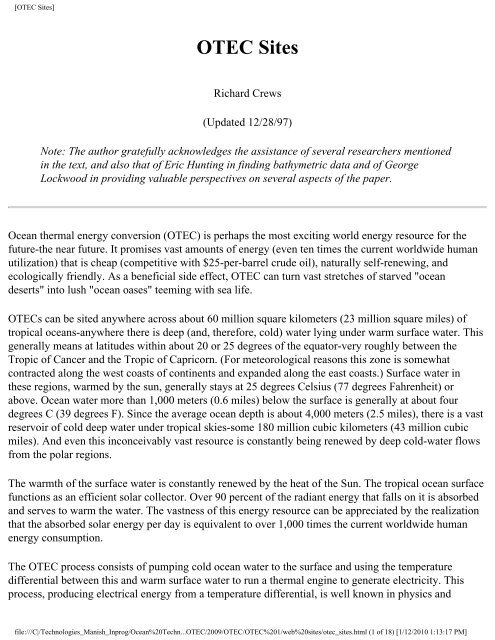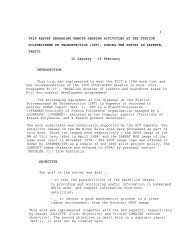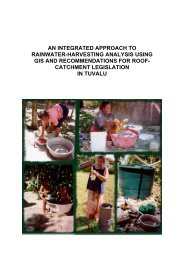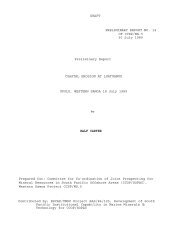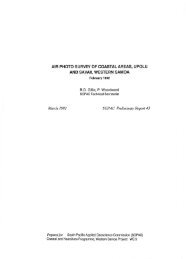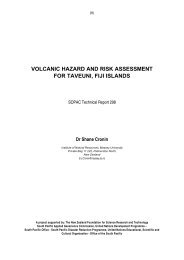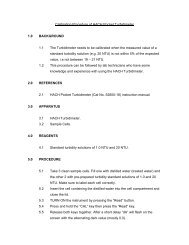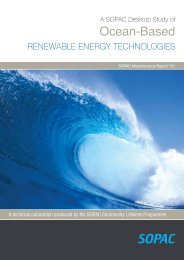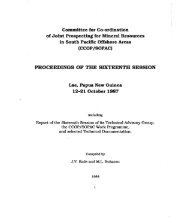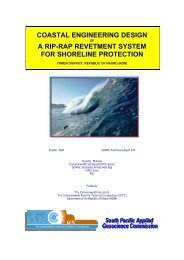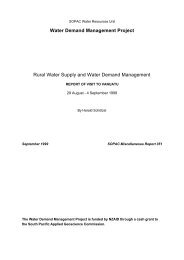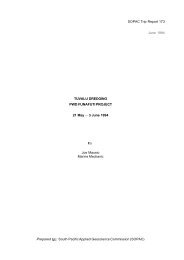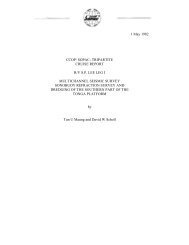OTEC Site Criteria - Up To
OTEC Site Criteria - Up To
OTEC Site Criteria - Up To
Create successful ePaper yourself
Turn your PDF publications into a flip-book with our unique Google optimized e-Paper software.
[<strong>OTEC</strong> <strong>Site</strong>s]<br />
<strong>OTEC</strong> <strong>Site</strong>s<br />
Richard Crews<br />
(<strong>Up</strong>dated 12/28/97)<br />
Note: The author gratefully acknowledges the assistance of several researchers mentioned<br />
in the text, and also that of Eric Hunting in finding bathymetric data and of George<br />
Lockwood in providing valuable perspectives on several aspects of the paper.<br />
Ocean thermal energy conversion (<strong>OTEC</strong>) is perhaps the most exciting world energy resource for the<br />
future-the near future. It promises vast amounts of energy (even ten times the current worldwide human<br />
utilization) that is cheap (competitive with $25-per-barrel crude oil), naturally self-renewing, and<br />
ecologically friendly. As a beneficial side effect, <strong>OTEC</strong> can turn vast stretches of starved "ocean<br />
deserts" into lush "ocean oases" teeming with sea life.<br />
<strong>OTEC</strong>s can be sited anywhere across about 60 million square kilometers (23 million square miles) of<br />
tropical oceans-anywhere there is deep (and, therefore, cold) water lying under warm surface water. This<br />
generally means at latitudes within about 20 or 25 degrees of the equator-very roughly between the<br />
Tropic of Cancer and the Tropic of Capricorn. (For meteorological reasons this zone is somewhat<br />
contracted along the west coasts of continents and expanded along the east coasts.) Surface water in<br />
these regions, warmed by the sun, generally stays at 25 degrees Celsius (77 degrees Fahrenheit) or<br />
above. Ocean water more than 1,000 meters (0.6 miles) below the surface is generally at about four<br />
degrees C (39 degrees F). Since the average ocean depth is about 4,000 meters (2.5 miles), there is a vast<br />
reservoir of cold deep water under tropical skies-some 180 million cubic kilometers (43 million cubic<br />
miles). And even this inconceivably vast resource is constantly being renewed by deep cold-water flows<br />
from the polar regions.<br />
The warmth of the surface water is constantly renewed by the heat of the Sun. The tropical ocean surface<br />
functions as an efficient solar collector. Over 90 percent of the radiant energy that falls on it is absorbed<br />
and serves to warm the water. The vastness of this energy resource can be appreciated by the realization<br />
that the absorbed solar energy per day is equivalent to over 1,000 times the current worldwide human<br />
energy consumption.<br />
The <strong>OTEC</strong> process consists of pumping cold ocean water to the surface and using the temperature<br />
differential between this and warm surface water to run a thermal engine to generate electricity. This<br />
process, producing electrical energy from a temperature differential, is well known in physics and<br />
file:///C|/Technologies_Manish_Inprog/Ocean%20Techn...<strong>OTEC</strong>/2009/<strong>OTEC</strong>/<strong>OTEC</strong>%201/web%20sites/otec_sites.html (1 of 18) [1/12/2010 1:13:17 PM]
[<strong>OTEC</strong> <strong>Site</strong>s]<br />
engineering. In fact, it is the reverse of the common refrigeration process (which produces a temperature<br />
differential using electrical energy).<br />
What are the benefits of <strong>OTEC</strong>?<br />
1. The energy resources for <strong>OTEC</strong> are vast.<br />
2. The energy resources for <strong>OTEC</strong> are naturally self-renewing.<br />
3. <strong>OTEC</strong> is non-polluting, in fact, it is ecologically positive since it enriches nutrient-poor surface<br />
water and tends to “sink” carbon. The nitrogen, phosphorus, silica, and other nutrients raised<br />
from the deep are combined via photosynthesis with atomospheric and ocean-dissolved carbon<br />
dioxide to produce increased biomass and reduce atmospheric carbon load.<br />
4. <strong>OTEC</strong> is based on established turbine and refrigeration technologies.<br />
5. <strong>OTEC</strong> readily produces, as side benefits, considerable quantities of fresh water, sea foods, and<br />
marine-life-based industrial products, as well as chill-water for air conditioning* and cold-bed<br />
agriculture.**<br />
* Using the <strong>OTEC</strong>-byproduct chill-water can save 75% to 85% of air-conditioning costs. For a large<br />
commercial complex (e.g., hotel or offices) in a tropical climate this can be a significant factor--savings<br />
of the order of a million dollars a year for a large hotel.<br />
** Cold-bed agriculture uses chill-water in pipes beneath the surface of the soil to lower the<br />
temperature of plant roots. This has two advantages. First, it allows production of temperate-zone crops<br />
(such as certain leafy greens, fruits, and legumes) in the tropics which reduces transportation costs in<br />
bringing these crops to tropical consumers. Second, one can commonly produce several crops of these<br />
temperate-zone plants per year--production rates several times what is possible in temperate climates.<br />
This may be because of the high insolation or perhaps because keeping the roots at a significantly lower<br />
temperature than the leaves facilitates transpiration or other metabolic processes. In addition to coldbed<br />
agriculture, <strong>OTEC</strong> can produce abundant fresh water that can be used for irrigation of crops which<br />
is often severely limited in tropical regions.<br />
What are the disadvantages or limitations of <strong>OTEC</strong>?<br />
1. An <strong>OTEC</strong> facility requires a substantial initial capital outlay (in the range of $50 to $100 million<br />
for a “small” ten-megawatt plant).<br />
2. <strong>OTEC</strong> has not been demonstrated at full scale over a prolonged period with integrated power,<br />
mariculture, fresh-water, and chill-water production.<br />
3. <strong>OTEC</strong> is only feasible at relatively isolated sites (deep tropical oceans); from such sites, the<br />
power and marine products must be transported to market. (In general, the fresh water--and<br />
certainly the chill-water--cannot be transported more than a few miles economically.)<br />
4. <strong>OTEC</strong> is ecologically controversial--at least untested--in large scale and over a long period.<br />
5. The technology for <strong>OTEC</strong>, once tested and proven, will be applicable across wide geographic<br />
(and politically varied) areas; therefore, future profits will not securely inure to the adventurous<br />
file:///C|/Technologies_Manish_Inprog/Ocean%20Techn...<strong>OTEC</strong>/2009/<strong>OTEC</strong>/<strong>OTEC</strong>%201/web%20sites/otec_sites.html (2 of 18) [1/12/2010 1:13:17 PM]
[<strong>OTEC</strong> <strong>Site</strong>s]<br />
capitalists who develop <strong>OTEC</strong>.<br />
What must be done, then, to develop <strong>OTEC</strong>?<br />
It is technologically easier to build and run an <strong>OTEC</strong> facility on shore rather than floating on the open<br />
ocean. This is because a shore-based facility is not as vulnerable to severe storms or high waves as a<br />
floating facility. In addition, siting a facility on shore allows local utilization of <strong>OTEC</strong> products and<br />
byproducts (power, fresh water, mariculture products, and chill-water). This saves on storage,<br />
distribution, and marketing expenses.<br />
However, political (and particularly business and ecological constraints) may make it impossible to have<br />
initial <strong>OTEC</strong> sites near or on shore. It may be necessary to have the first few <strong>OTEC</strong>s demonstrating<br />
prolonged operational integrity and value afloat on the open tropical oceans. Nevertheless, shore-based<br />
<strong>OTEC</strong>s are technologically easier to build and to run. It is therefore an important exercise to try to find a<br />
geographically, politically, and economically suitable coastal site for <strong>OTEC</strong>.<br />
An <strong>OTEC</strong> facility can only be financed two ways: as a local utility or by venture capital. It should be<br />
possible to make a preliminary assessment of the feasibility of each of these financial paths. First, how<br />
extensive is the local utility infrastructure (power, water, transportation, etc.) and how is it funded for<br />
construction and maintenance? This information might provide some guidance as to whether the<br />
political structure of the area is amenable to <strong>OTEC</strong> development. Second, is there significant venture<br />
capital invested in the area? If there is not, it is probably because the effective political and economic<br />
forces are not conducive to it.<br />
A careful analysis must be made of possible shore-based sites around the world. This involves several<br />
factors.<br />
1. One must identify tropical sites where there is deep ocean water very near shore (within, say, ten<br />
kilometers or six miles). This is because the huge <strong>OTEC</strong> intake pipes are a major portion of the<br />
initial capital expense. It is important to make them as short as possible. This paper considers a<br />
maximum possible length to be ten kilometers (six miles). However, some authorities consider<br />
the practical maximum cold-water-pipe length to be much shorter than this, perhaps at most two<br />
or three kilometers (one or two miles).<br />
2. One must then determine which of these sites have accommodating governments (for permitting,<br />
proprietary ownership, construction, labor, taxes, marketing products, etc.). George Lockwood<br />
points out (in a personal communication) that political risk insurance is available from the World<br />
Bank and the U.S. Overseas Investment Corporation at modest costs. He reports that there are<br />
very few countries where risks of expropriation or appropriation cannot be mitigated.<br />
3. In addition, one must establish which of these sites have adequate local infrastructure to absorb<br />
an additional five or ten megawatts of power and several million gallons of fresh water per day.<br />
(Note that some authorities project practical <strong>OTEC</strong> facilities as small as one megawatt with a halfmillion<br />
gallons of fresh water produced per day.) In fact, one of the most critical factors affecting<br />
file:///C|/Technologies_Manish_Inprog/Ocean%20Techn...<strong>OTEC</strong>/2009/<strong>OTEC</strong>/<strong>OTEC</strong>%201/web%20sites/otec_sites.html (3 of 18) [1/12/2010 1:13:17 PM]
[<strong>OTEC</strong> <strong>Site</strong>s]<br />
the feasibility of a shoreline <strong>OTEC</strong> site turns out to be availability of a willing buyer for the<br />
power. Furthermore, many power system engineers and financiers will not look much beyond<br />
diesel generation for power to remote locations since they consider diesel power to be proven and<br />
reliable. Calculation and projection of power and water needs can also be difficult.<br />
Socioculturally advanced communities use up to one megawatt of electricity and 400,000 liters<br />
(100,000 gallons) of water per day per 1,000 people. In less developed areas, people may use half<br />
as much water (though several times this amount may be needed in agricultural regions) and onetenth<br />
as much electricity. Bearing in mind these complexities, as a rule of thumb, for <strong>OTEC</strong><br />
development one is looking for a minimum population of at least 10,000 but, optimally, a<br />
population in excess of 50,000.<br />
In 1987 the Pacific International Center for High Technology Research (PICHTR) investigated shorebased<br />
sites in the Pacific region for <strong>OTEC</strong>. This analysis of thirty islands and Asian locations covered:<br />
● populations<br />
● economies<br />
● internal policies<br />
● energy demands and projections<br />
● <strong>OTEC</strong>-related cashcrop potential<br />
An analysis of distance to deep water of potential shoreline <strong>OTEC</strong> sites “near the U.S.” by William Gale<br />
(First Millennial Foundation, September 1996) concluded that the following were “most worthwhile to<br />
learn more about”:<br />
● the island of Hawaii<br />
● Providence Island in the Bahamas (Nassau)<br />
● St. Croix in the Virgin Islands<br />
● Grand Cayman<br />
In addition, Gale listed “other places that just might work” (that is, what would be needed next would be<br />
“tourist information”):<br />
● Belize<br />
● Bahamas, other islands<br />
● Caicos<br />
● Martinique<br />
● Jamaica<br />
● Guadeloupe<br />
● Grenada<br />
● Colombia<br />
file:///C|/Technologies_Manish_Inprog/Ocean%20Techn...<strong>OTEC</strong>/2009/<strong>OTEC</strong>/<strong>OTEC</strong>%201/web%20sites/otec_sites.html (4 of 18) [1/12/2010 1:13:17 PM]
[<strong>OTEC</strong> <strong>Site</strong>s]<br />
A book by Takahashi and Trenka titled Ocean Thermal Energy Conversion (John Wiley, 1996) lists 99<br />
nations and territories with access to <strong>OTEC</strong> thermal resources. This was based on a study performed for<br />
the U.S. Department of State in 1981.<br />
● There are 15 listed as “Americas--Mainland”<br />
● 23 as “Americas--Island”<br />
● 18 as “Africa--Mainland”<br />
● 5 as “Africa--Island”<br />
● 11 as “Indian/Pacific Ocean--Mainland”<br />
● 27 as “Indian/Pacific Ocean--Island”<br />
This list of 99 is longer than the PICHTR and Gale lists because geographically it has worldwide scope,<br />
and also because it considers ocean depths out to the full 200-nautical-mile EEZ (Exclusive Economic<br />
Zone) of each country. This would include possible floating <strong>OTEC</strong> facilities in addition to shore-based<br />
facilities which require that there be deep ocean within ten kilometers (six miles) of shore. In addition,<br />
this extensive list does not eliminate sites based on political and economic feasibility.<br />
This list of 99 can be reduced to 61 by eliminating areas that, although they have deep ocean within their<br />
EEZs, do not appear to have access to deep ocean within ten kilometers (six miles) of shore (based on<br />
charts in the Rand McNally Atlas of the Oceans, 1994, and the National Geographic Atlas of the World,<br />
1995, as well as data provided on the World Wide Web by the National Oceanic and Atmospheric<br />
Administration [NOAA]). Further reduction of the list to 29 is possible by eliminating those that are too<br />
small or have unstable or unreceptive political or business climates. (Much of the information on<br />
geography, politics, and economics summarized below was derived from the World Reference Almanac<br />
published by Dorling Kindersly, 1996; this was supplemented by guide books and other reference<br />
materials including the Web pages of the 1996 World Factbook.) The remaining 29 are as follows:<br />
● 15 listed as “Americas--Mainland” reduces to one, Mexico<br />
● 23 listed as “Americas--Island” reduces to 12<br />
● 18 listed as “Africa--Mainland” reduces to one, Tanzania<br />
● 5 listed as “Africa--Island” reduces to one, Madagascar<br />
● 11 listed as “Indian/Pacific Ocean--Mainland” reduces to one, India<br />
● 27 listed as “Indian/Pacific Ocean--Island” reduces to 13<br />
Americas--Mainland (reduces from 15 to one, Mexico)<br />
Mexico should probably be considered a relatively fertile field for foreign investment as well as ripe for<br />
extensive development of municipally funded infrastructure. However, there is endemic corruption at<br />
the national and state levels, a weak economy, chronically high inflation, and poverty-level wage scales.<br />
There was a severe debt crisis during the 1980s leading to Mexico defaulting on its international loans,<br />
and a bailout provided and financial restructuring required by the International Monetary Fund (IMF).<br />
The advent of the North American Free Trade Agreement (NAFTA) in 1994 linked the economies of the<br />
file:///C|/Technologies_Manish_Inprog/Ocean%20Techn...<strong>OTEC</strong>/2009/<strong>OTEC</strong>/<strong>OTEC</strong>%201/web%20sites/otec_sites.html (5 of 18) [1/12/2010 1:13:17 PM]
[<strong>OTEC</strong> <strong>Site</strong>s]<br />
U.S., Canada, and Mexico causing difficult political consequences, but probably with long-term positive<br />
and stabilizing effects on the Mexican economy. There was a devaluation of the Mexican peso in 1994<br />
with a $20-billion bailout loan from the U.S. The Mexican stock market experienced some recovery in<br />
1996. Mexico is known to have <strong>OTEC</strong>-accessible shoreline sites at the extreme southern tip of the Baja<br />
California peninsula (23°N, 110°W). It also appears, on bathymetric charts, to have three other possible<br />
sites: at Puerto Vallarta in Jalisco (20°30' N, 105°30' W), at Puerto Angel in Oxaca (16°N, 97°W), and<br />
along about 120 kilometers (75 miles) of the east coast of the Yucatan Peninsula from Punta Herrero to<br />
Xcalak in Quintana Roo (19°N, 88°W). .<br />
Of the other 14 areas listed under “Americas--Mainland,” 11 do not appear to have deep ocean water<br />
within ten kilometers (six miles) of shore: Belize, Costa Rica, El Slavador, French Guiana, Guatamala,<br />
Guyana, Honduras, Nicaragua, Panama, Suriname, and the United States. The other three are Brazil,<br />
Colombia, and Venezuela.<br />
Brazil appears to have <strong>OTEC</strong>-accessible shoreline sites along the eastern coast on a 1,100-kilometer<br />
(700-mile) stretch from north of Natal to south of Salvadore. However, foreign investment is deterred by<br />
corruption and xenophobic favoritism, and municipal infrastructural development is limited by chaotic,<br />
politicized financing.<br />
Colombia appears to have suitable sites for shore-based <strong>OTEC</strong> along the Pacific coast, but corruption<br />
and narcotics-related violence discourage foreign investment and infrastructural development.<br />
Venezuela is a major oil producer (one of the original OPEC countries). There is, therefore, little<br />
political/economic motivation for developing <strong>OTEC</strong> or other energy resources.<br />
Americas--Island (reduces from 23 to 12)<br />
(1) Antigua is the largest of the Leeward Islands in the West Indies, about 280 square kilometers (108<br />
square miles) with lush, tropical vegetation, a varied terrain, and some 365 beautiful beaches--all public.<br />
The resident population is small (about 65,000) but the island is visited by over a half-million tourists<br />
each year. Nealy half the resident population clusters near the city of St. John's. Antigua is economically<br />
limited, relying mainly on tourism. There are a few large resorts and casinos and many small hotels.<br />
Most hotels do not have air conditioning; temperatures are usually between 27 and 32 degrees C (in the<br />
80s F) but occasionally reach 35 degrees C (the mid 90s F); low humidity and year-round trade winds<br />
keep the ambient conditions comfortable. There is little rainfall, generally limited to rare, brief, heavy<br />
showers; water shortages occur frequently. The total electrical capacity is 52 megawatts. At present all<br />
energy needs depend on importation. There appear to be suitable sites for shore-based <strong>OTEC</strong> on the<br />
south coast by Cape Shirley (17° N, 61°45' W).<br />
(2) The Bahamas comprise an archipelago stretching 1,200 kilometers (750 miles) from near the Atlantic<br />
coast of Florida to the Caribbean Sea. There are 700 islands and 2,400 cays of which 30 are inhabited<br />
(total population under 300,000). There are two urban centers with most of the population: Nassau on<br />
file:///C|/Technologies_Manish_Inprog/Ocean%20Techn...<strong>OTEC</strong>/2009/<strong>OTEC</strong>/<strong>OTEC</strong>%201/web%20sites/otec_sites.html (6 of 18) [1/12/2010 1:13:17 PM]
[<strong>OTEC</strong> <strong>Site</strong>s]<br />
New Republic Island and Freeport on Grand Bahama. The climate is subtropical with occasional<br />
hurricanes from July to December. The Bahamas are stable politically with a developing economy with<br />
considerable tourism and international banking and ship registry. Infrastructure is quite limited. The total<br />
electrical capacity is 424 megawatts. All energy requirements are currently met by importation. There<br />
appear to be sites suitable for shore-based <strong>OTEC</strong> on New Providence Island along a 20-kilometer (13mile)<br />
stretch of the north and west coasts from Nassau to Adelaide (25° N, 78°30' W).<br />
(3) The Cayman Islands* are located in the Caribbean Sea some 150 kilometers (100 miles) south of<br />
Cuba. There are three Cayman Islands: Grand Cayman (200 square kilometers or 76 square miles, half<br />
of which is swamp) and two small islands, Little Cayman (25 square kilometers or 10 square miles) and<br />
the slightly larger Cayman Brac. Nearly all the population of 30,000 is on Grand Cayman (one-fourth in<br />
George <strong>To</strong>wn). The Caymans are a politically stable British territory with a high standard of living and<br />
little crime, economically dependent on tourism (one million per year) and on providing international<br />
financial services. The climate is pleasant year-round with an average temperature of 26 degrees C (79<br />
degrees F). Because of the porous rock base, there are no rivers or streams. Water is collected in home<br />
cisterns and also provided at $14.32 per 1,000 gallons by a municipal utility that uses reverse osmosis.<br />
Business licenses are granted to foreigners on elaborate application, and are good for 12 years<br />
(renewable). There are 10,000 foreigners living in the Caymans on "work permits" which are for three<br />
years (renewable). The greatest need is for professional and management staff; natives are given<br />
preference. There appear to be suitable sites for shore-based <strong>OTEC</strong> on Grand Cayman (19° 30' N, 81°<br />
30' W) which presently has a total power grid of 70 megawatts (Cayman Brac and Little Cayman have<br />
an additional four megawatts).<br />
* Note: Much of the information on the Cayman Islands was provided by Gary W. Frame.<br />
(4) Dominica (population of 71,000) is one of the Windward Islands in the West Indies. It is 47<br />
kilometers (29 miles) by 26 kilometers (16 miles) of rough, varied terrain including tropical rain forests<br />
and mountains as high as 1,400 meters (4,700 feet). The political system is democratic, an independent<br />
republic within the British Commonwealth. The economy is very limited, based largely on bananas.<br />
<strong>To</strong>urism, though being promoted, is limited by a rugged coastline and the absence of a large airport.<br />
Annual rainfall of 1,000 centimeters (400 inches) provides adequate water; in fact, Dominica exports<br />
water. <strong>To</strong>tal electrical capacity is seven megawatts. Energy needs are currently met by importation.<br />
Dominica appears to have suitable sites for shore-based <strong>OTEC</strong> along the west shore (15° 30' N, 61° 30'<br />
W).<br />
(5) The Dominican Republic (population of 7.8 million) shares the island of Hispaniola with Haiti, lying<br />
between Cuba and Puerto Rico in the Greater Antilles portion of the West Indies. The economy is based<br />
mainly on tourism (two million tourists per year), mining nickel and gold, and production of sugar and<br />
tobacco (as well as transshipment of narcotics). The historical political control by rich white landowners<br />
and the military has recently been democratizing. However, the Dominican Republic probably does not<br />
present an attractive business investment environment. Although the government officially welcomes<br />
foreign investment and has enacted facilitating legislation, there are significant barriers. The business<br />
climate is highly centralized and tends to be bureaucratic, unstable, and confusing. The government has<br />
file:///C|/Technologies_Manish_Inprog/Ocean%20Techn...<strong>OTEC</strong>/2009/<strong>OTEC</strong>/<strong>OTEC</strong>%201/web%20sites/otec_sites.html (7 of 18) [1/12/2010 1:13:17 PM]
[<strong>OTEC</strong> <strong>Site</strong>s]<br />
weak economic policies with a tendency to resort to monetary expansion to finance public expenditures.<br />
The government owns most public utilities and a variety of other enterprises such as insurance<br />
companies, banks, and factories, most of which lose money routinely. The banking system is not well<br />
regulated; loans are expensive; there is no deposit insurance. The government-owned electric power<br />
company does not have sufficient capacity. Power outages are frequent. Most industrial enterprises have<br />
their own back-up (or entirely independent) power. Two new dams are being built to provide<br />
hydroelectric power. Considerable oil (two million tons per year) is imported from Venezuela and<br />
Mexico. The Dominican Republic appears to have <strong>OTEC</strong>-feasible shoreline sites along the north<br />
(Atlantic) coast (20° N, 70° 30' W), but it seems unlikely that these can be developed in the present<br />
political and business climate.<br />
(6) Guadeloupe is the most northerly of the Windward Islands group in the Lesser Antilles portion of the<br />
West Indies. It consists mainly of two large islands, Grande-Terre and Basse-Terre, each about 770<br />
square kilometers (300 square miles). These two islands are joined by a 6.5 kilometer (four-mile) bridge.<br />
There are also several smaller islands bringing the total land area to 1,700 square kilometers (660 square<br />
miles). The climate is humid subtropical, modified by trade winds. There are periodic water shortages<br />
and occasional severe droughts; hurricanes occur between June and October. Guadeloupe has a total<br />
population of 413,000. The government is an overseas department of France. There is high<br />
unemployment and an economy largely limited to bananas, sugar production, and tourism (there are<br />
160,000 tourists per year, mainly from Europe). There is little industrialization. The total electrical<br />
capacity is 320 megawatts. Most fuel is imported. The Gardel factory which does all sugar<br />
manufacturing on the island has an attached electric power plant that burns coal and bagasse (crushed<br />
sugar cane). There appear to be suitable sites for shore-based <strong>OTEC</strong> along the west coast of Basse-Terre<br />
(16° N, 61°45' W).<br />
(7) Jamaica* (18° N, 77° W), at 11,400 square kilometers (4,400 square miles), is the third largest island<br />
in the West Indies. It is south of Cuba. It has a population of 2.5 million with 250,000 tourists per year.<br />
The largest metropolitan area is Kingston with 850,000 residents. It has political and economic life<br />
formerly influenced by family favoritism and narcotics trafficking and characterized by violence.<br />
However, in recent years it has developed quite a salutary democratic government, and it has a broadbased<br />
economy including mining and refining bauxite for aluminum (a very energy-intensive process),<br />
tourism, and significant agricultural production of sugar, bananas, rum, and coffee. Zoning and<br />
environmental regulations do not appear significantly restrictive although bureaucratic delays are<br />
common. Water supplies are a problem because of silt from deforestation and poor upkeep of treatment<br />
plants. There are occasional droughts although periodic water shortages can be attributed more to limited<br />
infrastructure andplanning. Utility prices tend to be high. Foreign ownership of businesses is allowed<br />
although joint ventures are preferred. There are tax incentives for companies that earn foreign exchange,<br />
use Jamaican raw materials, create employment opportunities for Jamaicans, or introduce new<br />
technologies. The tax incentives can be relief from all taxes for up to ten years; for horticulture and fish<br />
farming, the tax relief can be up to fifteen years. Both political parties support deregulation,<br />
liberalization of the economy, reducing tariffs, and ending import restrictions. The government is<br />
working on antitrust legislation to reduce constraints on the economy from monopolies. Jamaica is<br />
known to have suitable sites for shore-based <strong>OTEC</strong>. Preliminary designs for a one-megawatt land-based<br />
file:///C|/Technologies_Manish_Inprog/Ocean%20Techn...<strong>OTEC</strong>/2009/<strong>OTEC</strong>/<strong>OTEC</strong>%201/web%20sites/otec_sites.html (8 of 18) [1/12/2010 1:13:17 PM]
[<strong>OTEC</strong> <strong>Site</strong>s]<br />
<strong>OTEC</strong> pilot plant were completed in the early 1980s. There are also negotiations currently under way in<br />
conjunction with Kaiser Aluminum for a shore-based <strong>OTEC</strong> in Jamaica to provide power for bauxite<br />
refineries.<br />
* Note: Much of the information on Jamaica was provided by William Gale.<br />
(8) Martinique is one of the Windward Islands in the Lesser Antilles portion of the West Indies. It is<br />
1,100 square kilometers (425 square miles), mostly mountains but with varied terrain-and with an active<br />
volcano. The climate is tropical and humid, moderated by trade winds. It is vulnerable to hurricanes and<br />
flooding ( the rainy season is June to October). Martinique has a population of 371,000 about half of<br />
whom live in the capital, Fort-de-France. Legally it is a French "overseas department." The economy is<br />
based on tourism and on growing sugarcane and bananas (there is some transshipment of narcotics<br />
bound for the U.S. and Europe). Economic power resides with a wealthy white landowning minority.<br />
There is a high standard of living despite high unemployment. Martinique has minimal industry; the<br />
total electrical capacity is 113 megawatts. Crude oil is imported; there is some export of refined<br />
petroleum products. There appear to be sites suitable for shore-based <strong>OTEC</strong> along the west and south<br />
coasts (14° 30' N, 61° W).<br />
(9) Puerto Rico is a large island, 177 kilometers (110 miles) by 56 kilometers (35 miles), one of the<br />
Greater Antilles of the West Indies, roughly at 18° N, 66° W. It has a population of 3.6 million (plus<br />
four million tourists per year). It is a commonwealth territory of the U.S. with stable politics and a strong<br />
financial and industrial base, especially in apparel manufacturing, electronics, and petrochemicals. There<br />
are government incentives for manufacturing including tax exemptions, loans, and research assistance.<br />
There has been considerable influx of capital, technology, and entrepreneurship from mainland U.S.<br />
Agriculture is of two sorts, small subsistence farms and large export farms. Coffee is the most valuable<br />
crop followed by vegetables, sugar cane, bananas, pineapple, tobacco, and rice; dairy products, poultry,<br />
and beef are also important. Mineral extraction exceeds $160 million per year; this is mainly cement,<br />
sand, gravel, and stone, plus less significant amounts of clay, graphite, lime, and salt. Puerto Rico has a<br />
high standard of living, but also a high crime rate. Fresh-water demand is around 200 cubic meters (60<br />
million cubic feet) per day at $0.32 per cubic meter ($9 per thousand cubic feet). There are summer<br />
water shortages. Peak electricity demand in 1983 was 1,878 MWe at 10.42 cents per kilowatt-hour; this<br />
cost was expected to triple by the year 2000. Most (98%) of the electricity is generated by petroleumburning<br />
plants.<br />
The University of Puerto Rico campus at Mayaguez on the west coast has a graduate department of<br />
Marine Science. This department offers academic specialization in aquaculture as well as in several<br />
branches of oceanography and marine biology. Much of the teaching and research is carried out at a<br />
marine center 35 kilometers (22 miles) south of Mayaguez.<br />
Puerto Rico is known to have a site suitable for shoreline-<strong>OTEC</strong> on the southeast coast near Maunabo<br />
(65° 53' W). The Puerto Rico Power Authority proposed, in 1981, a 40-MWe (net) closed-cycle <strong>OTEC</strong><br />
that was to be constructed on a tower 200 meters (one-eighth mile) off Punta Tuna near Maunabo<br />
file:///C|/Technologies_Manish_Inprog/Ocean%20Techn...<strong>OTEC</strong>/2009/<strong>OTEC</strong>/<strong>OTEC</strong>%201/web%20sites/otec_sites.html (9 of 18) [1/12/2010 1:13:17 PM]
[<strong>OTEC</strong> <strong>Site</strong>s]<br />
(Avery and Wu, Oxford, 1994). Close inspection of coastal bathymetric data provided by the U.S. Army<br />
(available at http://bigfoot.wes.army.mil/b502.html) shows no other location along the Puerto Rican<br />
shoreline that has 1,000-meter (3,000-foot) deep ocean within ten kilometers (six miles) of the coast.<br />
(10) Saint Lucia is one of the Windward Islands in the Lesser Antilles portion of the West Indies. The<br />
climate is tropical moderated by trade winds; the rainy season from May to August includes hurricanes.<br />
Saint Lucia has a population of 145,000. It has a multiparty democracy and an economy which is<br />
growing although it is weak, largely based on bananas and foreign-owned tourist facilities with some<br />
developing industry and information processing. The total electrical capacity is 20 megawatts. At<br />
present most energy is imported; there are plans to develop geothermal resources. It appears to have<br />
suitable sites for shore-based <strong>OTEC</strong> along the southern part of the west coast (13° 45' N, 61° W).<br />
(11) Saint Vincent, one of the Windward Islands in the Lesser Antilles portion of the West Indies, is<br />
about 345 square kilometers (133 square miles) and has a population of about 100,000. The climate is<br />
tropical with little seasonal variation in temperature. The rainy season is May to November and includes<br />
hurricanes. There is a very limited economic base (based largely on bananas) but adequate political<br />
stability and growing infrastructure and industrialization. The total electrical capacity is 17 megawatts.<br />
There is a hydroelectric plant, but most energy needs are met by importation. There appear to be sites<br />
suitable for shore-based <strong>OTEC</strong> along the north and west coasts (15° 30' N, 61° 15' W).<br />
(12) The U.S. Virgin Islands are located just east of Puerto Rico at the north end of the Leeward Islands<br />
in the Lesser Antilles portion of the West Indies. Politically this is a U.S. territory with non-voting<br />
representation in the U.S. Congress. It has stable political structure and good financial services,<br />
infrastructure, and industrial base on the largest islands, Saint Thomas and Saint Croix. <strong>To</strong>urism<br />
amounts for more than 70% of the GNP. The total population of 104,000 is 80% on St. Thomas. The<br />
climate is subtropical and not overly humid. There are limited fresh-water resources, impacted by<br />
frequent and severe droughts and floods. The rainy season is May to November. <strong>To</strong>tal electrical capacity<br />
is 320 megawatts. Saint Croix is known to have suitable sites for shore-based <strong>OTEC</strong> along the north and<br />
northwest coasts (17°45' N, 64°50' W); Saint Thomas does not appear to have suitable sites. Saint Croix<br />
has one of the world's largest oil refineries. Historical research on deep-sea nutrients for <strong>OTEC</strong>associated<br />
mariculture was done on Saint Croix by O. A. Roels (1976).<br />
Six island areas listed in the State Department report do not appear to have deep ocean within ten<br />
kilometers of shore: Aruba, Barbados, Grenedines, Saint Kitts and Nevis, Trinidad and <strong>To</strong>bago, and<br />
Montserrat. The other five are Barbuda, Cuba, Curacao, Grenada, and Haiti.<br />
Barbuda, a political dependency of Antigua, is listed separately from Antigua in the 1981 U.S. State<br />
Department survey. Although it does appear to have possible shoreline <strong>OTEC</strong> sites, it has a very small<br />
resident population (about 1,500).<br />
Cuba is a communist dictatorship under U.S. trade embargo.<br />
file:///C|/Technologies_Manish_Inprog/Ocean%20Tech...TEC/2009/<strong>OTEC</strong>/<strong>OTEC</strong>%201/web%20sites/otec_sites.html (10 of 18) [1/12/2010 1:13:17 PM]
[<strong>OTEC</strong> <strong>Site</strong>s]<br />
Curacao, part of the Netherlands Antilles, has been politically unstable with financial difficulties<br />
(including drug trafficking).<br />
Grenada has been politically unstable and economically weak.<br />
Haiti is politically corrupt and unstable with a weak economic base.<br />
Africa--Mainland (reduces from 18 to one, Tanzania)<br />
Tanzania on the east coast of Africa (5° to 10° S, 40° E) has a population of 29.7 million). Though it is<br />
perhaps the best candidate for <strong>OTEC</strong> development on the African continent, Tanzania is a very poor<br />
country with an economy heavily dependent on agriculture (58% of GNP, 85% of exports, 90% of the<br />
workforce). There is very limited industrial development, mainly consisting of processing of agricultural<br />
products with some mining and oil refining. Natural resources awaiting more extensive development<br />
include tin, phosphates, iron, diamonds, gemstones, gold, and nickel. Tanzania has a multiparty<br />
democracy and state commitment to reforms that have cut inflation and budget deficits. There is limited<br />
foreign investment, but a receptive political and economic climate. Currently more than 90% of energy<br />
demand is met from wood and charcoal; hydropower provides 70% of electricity and is being expanded.<br />
The total electrical capacity is 440 megawatts. Oil imports are substantial; there are new oil discoveries<br />
and some development of offshore gas resources. There appear to be suitable sites for shore-based<br />
<strong>OTEC</strong> at five locations: on the north coast just south of Tanga, at Dar Es Salam, along the south coast<br />
around Lindi, and on the islands of Zanzibar and Pemba.<br />
Eleven of the countries on the African mainland with <strong>OTEC</strong>-feasible ocean within their EEZs do not<br />
appear to have deep ocean water within ten kilometers (six miles) of shore: Angola, Cameroon, Congo,<br />
Gabon, Guinea, Ivory Coast, Kenya, Liberia, Nigeria, <strong>To</strong>go, and Zaire. An additional five can be<br />
eliminated from the list because of political and financial instability: Benin, Equatorial Guinea,<br />
Mozambique, Sierra Leone, and Somalia. Finally, Ghana has surplus hydroelectric power from the Volta<br />
Dam.<br />
Africa--lsland (reduces from 5 to one, Madagascar)<br />
Madagascar is a large island off the east coast of Africa with a population of 14.8 million. Although<br />
Madagascar is perhaps the most favorable African island for development of <strong>OTEC</strong>, it is a very poor<br />
country with chronic malnutrition and underfunded health and education resources. It has a new<br />
multiparty democracy which replaced a stifling socialistic regime in 1993, but continues to be plagued<br />
by corruption, instability, and erratic commitment to economic reforms. The weak economy has a varied<br />
agricultural base with exports of vanilla, coffee, and cloves, as well as prawns. The country has<br />
commercialization of off-shore oil and gas resources, and significant tourism. There is limited<br />
infrastructure with an extensive domestic air network but poor road and rail systems. There is<br />
widespread soil erosion from deforestation and overgrazing. Surface waters are often contaminated with<br />
raw sewage and other organic wastes. The island is often hit by cyclones and plagued by severe<br />
file:///C|/Technologies_Manish_Inprog/Ocean%20Tech...TEC/2009/<strong>OTEC</strong>/<strong>OTEC</strong>%201/web%20sites/otec_sites.html (11 of 18) [1/12/2010 1:13:17 PM]
[<strong>OTEC</strong> <strong>Site</strong>s]<br />
flooding. The total electrical capacity is 220 megawatts. Madagascar imports petroleum. It appears to<br />
have suitable sites for shore-based <strong>OTEC</strong> at the northern tip near Antsiranana (12° S, 49° E).<br />
The other four African island areas can be dropped from the list for political/financial reasons: Aldabra<br />
[UK], Ascension [UK], Comoros (total power grid under one megawatt), and Sao <strong>To</strong>me and Principe.<br />
Indian/Pacific Ocean--Mainland (reduces from 11 to one, India)<br />
India has a multiparty democracy and commitment to free-market economic development. On the other<br />
hand, there is high unemployment, poor infrastructure, high inflation, and huge budget deficits. In<br />
addition, although there is both a large foreign-investment establishment and an influx of multinational<br />
investment capital, there is also widespread hostility to foreign investment. Sea Solar Power of York,<br />
Pennsylvania negotiated, in the mid 1990s, for the construction of <strong>OTEC</strong> facilities off the coast of Tamil<br />
Nadu in southern India; contracts were not finalized due to disagreements about financial risk<br />
management and power sales on the local utility grid (according to a private communication from Phil<br />
Kopitske). India appears to have a very limited stretch of suitable sites for shore-based <strong>OTEC</strong> along the<br />
Bay of Bengal near Amalapuram (16° 30' N, 82° 30' E).<br />
Japan can be dropped from consideration for new <strong>OTEC</strong> because it is at the forefront of <strong>OTEC</strong> research<br />
and development (as are the U.S. and Taiwan).<br />
Australia can be dropped from consideration because it does not appear to have deep ocean within ten<br />
kilometers of shore along the northern half of the continent, whereas the southern half does not have<br />
warm enough surface water. In addition, Australia imposes paralyzing ecological constraints on any<br />
unusual development.<br />
Seven additional nations and territories can be dropped from the “Indian/Pacific Ocean--Mainland” list<br />
because they do not appear to have deep ocean water within ten kilometers of shore: Bangladesh,<br />
Brunei, Burma, China, Hong Kong [listed in 1981 as separate from China], Malaysia, and Thailand. In<br />
addition, Vietnam can be dropped because of political/financial instability.<br />
Indian/Pacific Ocean--lsland (reduces from 27 to 13)<br />
(1) American Samoa in the South Pacific Ocean is a U.S. territory consisting of the island of Tutuila<br />
(137 square kilometers or 53 square miles) and six smaller islands. The population is only 60,000 (with<br />
95% on Tutuila). The economy is based largely on government service (one-third of the workforce),<br />
tuna processing (another third), plus minimal light industry and tourism (a few thousand visitors per<br />
year). The climate is hot and humid year-round. Typhoons are common from December to March.<br />
<strong>To</strong>urist accommodations are relatively expensive. Pollution has been a problem. Water resources are<br />
limited, much depending on roof catchments. The total electrical capacity is 30 megawatts. Petroleum<br />
products are imported. There appear to be suitable sites for shore-based <strong>OTEC</strong> on Tutuila (15° S, 170°<br />
W).<br />
file:///C|/Technologies_Manish_Inprog/Ocean%20Tech...TEC/2009/<strong>OTEC</strong>/<strong>OTEC</strong>%201/web%20sites/otec_sites.html (12 of 18) [1/12/2010 1:13:17 PM]
[<strong>OTEC</strong> <strong>Site</strong>s]<br />
(2) French Polynesia, some 130 islands in the southeast Pacific Ocean, has adequate population only on<br />
the main island of Tahiti (about 150,000). The economy is thin, largely based on tourism. The climate is<br />
tropical but moderate. There are occasional cyclonic storms in January. The total electrical capacity is 75<br />
megawatts. Fuels are imported. Tahiti (17° 30' S, 149° 30' W) is known to have deep ocean water close<br />
enough off shore to make shore-based <strong>OTEC</strong> feasible. The French did a feasibility study for five-totwenty-megawatt<br />
open-cycle and closed-cycle <strong>OTEC</strong> in Tahiti in 1978-80. Construction on a fivemegawatt<br />
plant was begun near Papeete (17°32' S, 149° 35' W). It was scheduled for completion in<br />
1985, but not brought to operational status. There also appear to be other possible shoreline-<strong>OTEC</strong> sites<br />
on Tahiti.<br />
(3) Guam is in the North Pacific Ocean roughly 2,500 kilometers (1,500 miles) from Japan to the north,<br />
from The Philippines to the west, and from Australia to the south (13° N, 145° E). The climate is<br />
tropical marine, generally warm and humid, though moderated by northeast trade winds; there is little<br />
seasonal temperature variation. The rainy season runs from July to December with occasional typhoons<br />
in August. Guam has adequate population (157,000) and infrastructure. Its politics are dominated by the<br />
indigenous Chamorro people. It boasts a high standard of living and thriving economy but these are<br />
based largely on tourism and an enormous U.S. military base. The total electrical capacity is 300<br />
megawatts. Petroleum products are imported. Guam appears to have suitable sites for shore-based <strong>OTEC</strong><br />
at two locations: along the northeast coast from Pati Point to Catalina Point and along the west coast<br />
from Asan to Meriza.<br />
(4) Indonesia, in southeast Asia, is the world's largest archipelago. There are five main islands (Sumatra,<br />
Java, Kilimantan [mainly Borneo], Irian Java, and Sulawesi), but a total of 13,677 islands spread across<br />
5,000 kilometers (3,100 miles) between the Indian Ocean to the west and the South China Sea and<br />
Philippine Sea of the Pacific Ocean to the east. Indonesia is the fourth most populous nation in the world<br />
with 200 million people. The population is very divergent; there are some 300 ethnic groups with more<br />
than 350 languages and dialects. Religion is predominantly Muslim (87%). There has been international<br />
concern about human-rights abuses and persecution of ethnic minorities. Politics is quasi-democratic,<br />
dominated by the largest ethnic group, the Javanese (45% of the population) and by the military<br />
(General Suharto has been president for 30 years). However, there is a generally favorable economic and<br />
business climate. Big business is largely dominated by the Chinese ethnic groups. Bureaucratic delays<br />
and political corruption tend to impede business. Environmentally, Indonesia has been rather ineffective<br />
at stopping logging destruction of the world's second-largest tropical rain forest (the largest is in Brazil);<br />
some experts estimate that Indonesian rain forests will be gone in the next thirty years. Indonesia is rich<br />
in energy resources; for example, it is one of the world's leading exporters of liquefied natural gas. Other<br />
significant resources are oil, coal, bauxite, nickel, and agricultural products such as rubber and palm oil<br />
in addition to considerable lumber from logging forests (which cover 75% of the land area). Despite<br />
Indonesia's abundance of energy resources, with ultimately limited fossil-fuel production and growing<br />
domestic energy demands, the government is considering development of geothermal and nuclear<br />
energy over the next few decades. In addition, there appear to be feasible shoreline sites for <strong>OTEC</strong> at<br />
numerous locations throughout the Indonesian archipelago.<br />
file:///C|/Technologies_Manish_Inprog/Ocean%20Tech...TEC/2009/<strong>OTEC</strong>/<strong>OTEC</strong>%201/web%20sites/otec_sites.html (13 of 18) [1/12/2010 1:13:17 PM]
[<strong>OTEC</strong> <strong>Site</strong>s]<br />
(5) The Maldives* are in the Indian Ocean roughly 800 kilometers (500 miles) off the southern tip of<br />
India. There is a total population of 300,000. The Maldives comprise nearly 1,200 low coral islands of<br />
which 200 are populated, but there is only one significant population center, the capitol city of Male<br />
with 65,000. The culture is Islamic. Political power is organized around a few families. The economy is<br />
limited, dominated by tourism but including tuna fishing, coconut production, clothing industries, and<br />
shipping; fish export is the second largest industry (after tourism). Foreign investment has recently been<br />
encouraged by liberalizing regulations; it is now possible to have companies in the Maldives that are<br />
wholly owned by foreign parties. In addition, the Maldivian government is supposedly keen on projects<br />
that go beyond the usual tourist attractions and amenities. Manufacturing and infrastructural support in<br />
general are very limited. Drinking water for tourists and all oil products are imported. The total power<br />
grid is about five megawatts. The Maldives have a huge foreign (e.g., 17,000 Sri Lankans) "guest"<br />
workforce to make up for local workforce shortage. Bathymetric charts indicate there are feasible sites<br />
for shore-based <strong>OTEC</strong> near Male (5° N, 73° E).<br />
Note: much of the information on the Maldives was provided by Thomas Bjelkeman-Pettersson.<br />
(6) The Marshall Islands comprise a group of 30 atolls and 1,152 islands located between 4° and 14° N,<br />
and between 160° and 173° E, in the North Pacific Ocean about halfway between the Hawaiian Islands<br />
and Papua New Guinea (about 3,500 kilometers or 2,000 miles from each). The population amounts to<br />
about 60,000, half of whom live in the capital, Majuro. The Republic of the Marshall Islands has a<br />
constitutional government. Politics is based on the power of local chiefs. The official languages are<br />
English and Marshallese. There is a close association with and marked economic dependence on the U.<br />
S. which provides two-thirds of the gross national product as foreign aid. The Marshalls, particularly<br />
Bikini Atoll, have received considerable historical notoriety for U.S. nuclear bomb testing. The economy<br />
is very weak, based on small farms, limited tourism, and handicrafts produced from shells, wood, and<br />
pearls. Untapped resources appear to be limited to low-grade phosphate deposits and marine products.<br />
Attempts are being made to establish the Marshall Islands as an international offshore banking resource.<br />
The weather is tropical with occasional monsoons from May to November. Potable water is in short<br />
supply. The total electrical capacity is 42 megawatts, largely produced by small diesel generators using<br />
imported oil. There appear to be feasible shoreline <strong>OTEC</strong> sites. Majuro has reportedly been intensively<br />
studied for <strong>OTEC</strong>.<br />
(7) New Caledonia (20° to 23° S, 164° to 168° E) is in the South Pacific Ocean roughly 900 kilometers<br />
(1,450 miles) east of Australia. The climate is frankly tropical--hot and humid. It is a French overseas<br />
territory with a population of 188,000. The political climate has been quite unstable, at times violent, but<br />
there has been reasonable calm since reforms in 1988 with a referendum on independence promised for<br />
1998. The economy is limited to tourism, agriculture, and nickel mining. In addition to nickel there are<br />
natural resources of chrome, iron, cobalt, manganese, silver, gold, lead, and copper. The total electrical<br />
power capacity is 250 megawatts. Fuels are imported, as are foods and machinery. There appear to be<br />
suitable sites for shore-based <strong>OTEC</strong>.<br />
(8) The Northern Marianas (15° N, 145° E), a commonwealth territory of the U.S., lie in the North<br />
Pacific Ocean just north of Guam. The climate is tropical marine moderated by northeast trade winds<br />
file:///C|/Technologies_Manish_Inprog/Ocean%20Tech...TEC/2009/<strong>OTEC</strong>/<strong>OTEC</strong>%201/web%20sites/otec_sites.html (14 of 18) [1/12/2010 1:13:17 PM]
[<strong>OTEC</strong> <strong>Site</strong>s]<br />
with little seasonal temperature variation. The rainy season from July to October includes typhoons.<br />
Groundwater is contaminated in some places by raw sewage. The total electrical power capacity is 105<br />
megawatts. Petroleum products and foods are imported. There are known to be suitable sites for shorebased<br />
<strong>OTEC</strong>. However, the population is small (53,000) and the economy limited to tourism and<br />
subsistence farming.<br />
(9) The Philippines (10° to 20° N, 120° to 125° E), with a total population over 67 million, is known to<br />
have suitable sites for shore-based <strong>OTEC</strong>. There is a democratic government and growing, though<br />
agriculturally based, economy. Infrastructure is weak; there are often power outages. Foreign investment<br />
is welcome. There is extensive oil production and use of geothermal power.<br />
(10) The Seychelles (5° S, 55° E) have a total population of 73,000 on 115 islands. There is a total land<br />
area of 455 square kilometers (175 square miles). About half the islands are granitic--rocky and hilly<br />
with a narrow strip of coast; half are coralline--flat with elevated reefs. The climate is tropical marine:<br />
humid with temperatures year-round rarely dropping below 24 degrees C (75 degrees F). The Seychelles<br />
lie outside the cyclone belt so severe storms are rare. There are no natural fresh-water resources;<br />
catchements collect rain water; there are occasional short droughts. There is multiparty democracy. The<br />
economy is based on tourism, fishing (shrimp and tuna), and export of tuna, copra, cinnamon, and tea.<br />
There are significant trade and budget deficits, but a generally high standard of living with no slums and<br />
very little crime. Infrastructure is limited; there are airstrips on nine of the islands and power is<br />
generated by imported fuel on the three islands that have electricity supply systems. There appear to be<br />
suitable sites for shore-based <strong>OTEC</strong>.<br />
(11) The Solomon Islands (7° to 12° S, 156° to 163° E) have a total population of 400,000. They<br />
comprise several hundred islands with most of the population on the six largest (Guadalcanal, Malaita,<br />
New Georgia, Makira, Santa Isabel, and Choiseul). The climate is tropical monsoon with moderate<br />
temperatures. Political power resides in a multiparty parliament which is dominated by prominent<br />
figures from the villages. The economy is limited, based on copra and timber with subsistence<br />
agriculture. Infrastructure is limited. There is one major airport (on Guadalcanal). The total electrical<br />
capacity is 21 megawatts. Energy needs are currently met by importation. There appear to be suitable<br />
sites for shore-based <strong>OTEC</strong>.<br />
(12) <strong>To</strong>nga (20° S, 173° W), with a total population of 106,000, consists of an archipelago of 170 islands<br />
in the South Pacific Ocean a few hundred kilometers south of Samoa. The climate is tropical, modified<br />
by trade winds. Politics is dominated by the king, nobles, and wealthy landowners. There is subsistence<br />
agriculture with commercial production of coconut, cassava, and passion fruit. At present all energy<br />
needs are met by importation, transported in uneconomical 166-liter (44-gallon) units. The total<br />
electrical grid throughout <strong>To</strong>nga is about six megawatts. There appear to be suitable sites for shoreline<br />
<strong>OTEC</strong> but their proximity to population centers is not known.<br />
(13) Vanuatu (14° to 20° S, 166° to 170° E) is in the South Pacific Ocean. It was formerly called New<br />
Hebrides (UK/FR). Vanuatu consists of 82 islands, 12 of which are of significant size. The climate is<br />
file:///C|/Technologies_Manish_Inprog/Ocean%20Tech...TEC/2009/<strong>OTEC</strong>/<strong>OTEC</strong>%201/web%20sites/otec_sites.html (15 of 18) [1/12/2010 1:13:17 PM]
[<strong>OTEC</strong> <strong>Site</strong>s]<br />
tropical, moderated by southeast trade winds. There is a total population of 178,000. Politics is<br />
democratic but volatile. The economy is dominated by tourism and offshore financial services. There is<br />
subsistence farming and small-scale cash cropping. Copra and cocoa are exported. The total electrical<br />
power capacity is 17 megawatts. Nuclear power development has been banned by legislation. There<br />
appear to be suitable sites for shore-based <strong>OTEC</strong>.<br />
Three island areas (Hawaii, Okinawa [part of Japan], and Taiwan) can be dropped from further<br />
consideration for new <strong>OTEC</strong> because they are already at the forefront of <strong>OTEC</strong> research and<br />
development. However, <strong>OTEC</strong> has been developed on Hawaii only at the Natural Energy Laboratory at<br />
Keahole Point on the westernmost point of the "Big Island" of Hawaii. According to bathymetric data<br />
posted on the Web by the U.S. Army (http://bigfoot.wes.army.mil/b512.html), there are other possible<br />
sites on the southwest and southeast coasts of the island of Hawaii (19° to 19° 30' N, 154° 50' to 156° 5'<br />
W) and on two other of the Hawaiian Islands: on the south coast of Kahoolawe (20° 30' N, 156° 40'W)<br />
and on the southeast coast of Maui (20° 40' N, 156° to 156° 20' W). Mauritius and Western Samoa can<br />
be dropped from the list because they do not appear to have deep ocean water within ten kilometers (six<br />
miles) of shore. In addition, eleven island areas can be dropped because they are too small or have other<br />
political/financial limitations: Cook Islands, Indonesia, Fiji, Kiribati including Christmas Island, Nauru*,<br />
Palau, Papua New Guinea, Sri Lanka, Tuvalu, Wake Island, and Wallis and Futuna Islands.<br />
* Note that Nauru (0°30' S, 166°55' E) was the site of the first successful net-power generation by a landbased<br />
<strong>OTEC</strong> facility. According to Avery and Wu (Oxford, 1994) and an NOAA report (1986), the <strong>To</strong>kyo<br />
Electric Power Company and <strong>To</strong>shiba Corporation began plans in 1973 that projected a ten-megawatt<br />
prototype. The plant finally constructed and run in 1980-1982 was located on the southwest coast of<br />
Nauru by Yaren near the international airport. It was closed-cycle design using Freon as the working<br />
fluid and produced 100-120 kilowatts gross power (15-30 kilowatts net) which was successfully<br />
integrated with the local power grid. However, Nauru may not present a practical site for further <strong>OTEC</strong><br />
development. It is a very small island (population of 10,000) which has been 80% destroyed by<br />
phosphate mining. The population tends to be wealthy as a result of the phosphate mines, but phosphate<br />
deposits are expected to be exhausted by the year 2000. The island is supported by overseas investments<br />
and by an international fund established in compensation for exploitation of the phosphate deposits. The<br />
total electrical capacity of Nauru is 14 megawatts.<br />
The next step in finding feasible shoreline <strong>OTEC</strong> sites would be confirm on finer-scale regional depth<br />
charts which of these 29 nations and territories quite certainly have sites for shore-based <strong>OTEC</strong>. After<br />
that, one would do a more thorough survey of political and economic situations within each of these 29<br />
nations and territories to identify restrictive business, ecological, or other constraints that would make<br />
shoreline <strong>OTEC</strong> impossible. These two processes should distill out a few that warrant further evaluation.<br />
The criteria for further evaluation are listed below.<br />
<strong>OTEC</strong> <strong>Site</strong> <strong>Criteria</strong><br />
In assessing a potential shoreline site for development of an <strong>OTEC</strong> (ocean thermal energy conversion)<br />
file:///C|/Technologies_Manish_Inprog/Ocean%20Tech...TEC/2009/<strong>OTEC</strong>/<strong>OTEC</strong>%201/web%20sites/otec_sites.html (16 of 18) [1/12/2010 1:13:17 PM]
[<strong>OTEC</strong> <strong>Site</strong>s]<br />
facility, there are quite a number of factors that must be evaluated. After assuring that the geographic<br />
characteristics make <strong>OTEC</strong> feasible (tropical climate with near deep ocean), the most important<br />
considerations are political and infrastructural.<br />
● Is there a tropical climate? (What are the average monthly ambient temperatures through the<br />
year?)<br />
● What are the average monthly surface-water temperatures through the year?<br />
● Are there severe storms (typhoons, tornadoes, monsoons, high surf)?<br />
● What is the distance off shore to 1,000-meter ocean depth?<br />
● What is the shoreline construction base (sand, lava, bedrock, etc.)?<br />
● Is the political climate supportive of large infrastructural development?<br />
● Is it supportive of foreign investment from the standpoints of taxation, permitting, and emigration<br />
(or working visas) for foreigners?<br />
● Who are the local authorities (by names and positions)?<br />
● Are there prohibitive ecological constraints?<br />
● Are there local building-code constraints? (Is there large hotel construction in the area?)<br />
● What is the area population (and population density in the local 100-to-500-square-mile area)?<br />
● What is the local per-capita income?<br />
● What is the minimum hourly wage and the minimum (or average) construction and clerical<br />
hourly wages?<br />
● What is the local utilization of electricity, for example, the per-capita use? How does demand<br />
vary with daily or seasonal cycles?<br />
● How is electricity currently generated (diesel, hydroelectric, nuclear, wind, etc.), and are there<br />
currently specific power-generation development plans?<br />
● What is the total capacity of the local power grid?<br />
● Is there a willing buyer for power that would be produced by <strong>OTEC</strong>?<br />
● What is the population of transients (tourists) through the year?<br />
● What is the local tourist infrastructure (hotels, transportation, interesting sites)?<br />
● How densely is shoreline developed (how expensive and available are shoreline sites)?<br />
● What are present sources of fresh water (rivers, run-off, desalination, importation, etc.)?<br />
● What is the local market for fresh water (volume, cost per 1,000 gallons, per-capita use)?<br />
● Is there significant local fishing (commercial, tourist)?<br />
● What are the local markets for fish and marine-life products (prices, varieties, volumes)?<br />
● What is the local infrastructure for transport of products (fish, industrial products, water, etc.-highways,<br />
railways, seaport facilities, airports)?<br />
● Is there local demand for air-conditioning (or other uses of chill-water)?<br />
● Is there local industry (perhaps with significant power utilization)?<br />
● Is there local agriculture?<br />
● Would there be local interest, markets, competition regarding cold-bed agriculture (i.e.,<br />
temperate-zone fruits and vegetables)?<br />
● Is there local aquaculture (perhaps even mariculture)?<br />
file:///C|/Technologies_Manish_Inprog/Ocean%20Tech...TEC/2009/<strong>OTEC</strong>/<strong>OTEC</strong>%201/web%20sites/otec_sites.html (17 of 18) [1/12/2010 1:13:17 PM]
[<strong>OTEC</strong> <strong>Site</strong>s]<br />
[Home] [FMF Home] [FMF Europe Home]<br />
file:///C|/Technologies_Manish_Inprog/Ocean%20Tech...TEC/2009/<strong>OTEC</strong>/<strong>OTEC</strong>%201/web%20sites/otec_sites.html (18 of 18) [1/12/2010 1:13:17 PM]


